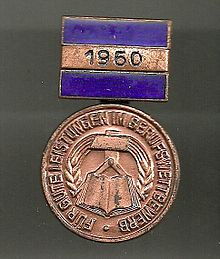Awards of the professional competition
The awards of the professional competition were a joint award of the central board of the Free German Youth (FDJ) and the Free German Trade Union Federation (FDGB) of the German Democratic Republic (GDR) which were donated in 1949. It was intended to honor excellent, very good and good performance in the youth professional competition. The presentation of these awards was stopped on November 19, 1970 with the foundation of the medal "For very good performance in the socialist professional competition" and the medal "Exemplary apprentice collective in the socialist professional competition" .
1949 to 1955
Up to 1955 , the medals were awarded in various designs and with different grading, so that complete documentation is almost impossible. There were medals with and without braces and different award procedures.
1956 to 1957
In 1956 a uniform medal with a diameter of 26 mm was introduced and awarded in three stages. These goods:
- Gold level: For excellent performance in competition
- Silver level: For very good performance in competition
- Bronze level: For good performance in competition
The medal shows on its obverse in the middle an open book in front of a hammer and compass. All three symbols are united by two wreaths of ears of corn, each of which goes up to the left and right of the book to the hammer. Together they form the symbol of professional competition. This was enclosed by a legend, which, depending on the level awarded, read:
- FOR EXCELLENT PERFORMANCE IN COMPETITION
- FOR VERY GOOD PERFORMANCE IN COMPETITION
- FOR GOOD PERFORMANCE IN COMPETITION
The reverse of the medal showed the emblem of the five-year plan in 1956 . A construct made up of the number 5, a hammer and compass and ray-shaped ears. The medal was worn on the upper left side of the chest on a blue enameled clasp in the middle of which a horizontal central bar was embossed, on which the year 1956 or 1957 could be read.
1957 to 1959
The medals of this period, in contrast to their predecessor model, remained unchanged on the obverse in terms of illustration; however, the inscription now read:
- FOR EXCELLENT PERFORMANCE IN PROFESSIONAL COMPETITION
- FOR VERY GOOD PERFORMANCE IN PROFESSIONAL COMPETITION
- FOR GOOD PERFORMANCE IN PROFESSIONAL COMPETITION
The lapel no longer showed the symbol of the five-year plan, but in the middle a cogwheel with the number 5 superimposed on it. The cogwheel was enclosed by two stalks of corn that were crossed at the bottom. As with its predecessor, the corresponding blue enamelled clasp showed the date of the award ( 1958 or 1959 ) , which was no longer embossed .
1960 and 1961
The medals from this period remained almost identical again, but instead of the cogwheel with the number 5, they now showed the symbol of the badge activist of the seven-year plan on their lapel : the number 7 and a circle, the ends of which are connected by a cogwheel segment, as well as on the left and on the right a stalk of corn. The blue enameled clasp also showed the year of the award ( 1960 , 1961 ) on a horizontal central bar .
1962 to 1970
From 1962 on the year of the award was waived, otherwise the medals corresponded to those of the previous period. The clasp now had two bars with an applied emblem ( 1962 - 1964 ) or, from 1964, one bar with an embossed emblem.
From 1970
→ see main article medal "For very good performance in socialist professional competition" and photo
Special forms
Craftsman
The medal for craftsmen is a special form that was awarded from 1957 to 1960 in the same grading. While her obverse remained unchanged, the lapel showed the symbol of the craft, an upright hammer with a balance attached to its hammer head. An oak leaf protruded from the hammer style on the left and an acorn on the right. At the lower edge of the medal under the hammer style, a semicircular gear-like structure can be seen that merges into stalks of corn after half of the circumference. From 1961, separate medals for the craft were no longer awarded.
Apprentice collective
Apprentice collectives, on the other hand, could be awarded an upside-down badge, which could also be awarded in three stages. The bronze, silver-plated or gold-plated badge showed two shaking hands at its lower tip. The square on top is rhombic and enamelled in dark blue. The symbol of the professional competition can be seen in the middle, which is enclosed by the inscription: FOR COLLECTIVE ACHIEVEMENTS . Both the hands, the lettering, the symbol of the professional competition and the edge of the square are kept in the color of the awarded level. If you only wanted to wear the ribbon, the medal could be hung up.
Individual evidence
- ^ Frank Bartel: Catalog of the awards and badges of the GDR. Volume 1: Free German Youth and Pioneer Organization "Ernst Thälmann". Regenstauf: Battenberg 2015. P. 65 f.
- ^ Frank Bartel: Catalog of the awards and badges of the GDR. Volume 1: Free German Youth and Pioneer Organization "Ernst Thälmann". Regenstauf: Battenberg 2015. p. 65.
- ^ Frank Bartel, Jürgen Karpinski: Awards of the German Democratic Republic. Military Publishing House of the GDR, Berlin 1979, p. 201.



